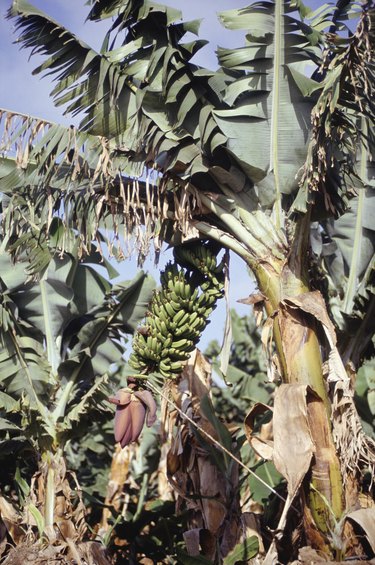
Commonly referred to as a tree, the banana plant is actually a large herb with a large pseudostem growing up from a fleshy rhizome. Suckers rise up around the main plant from the roots and form a clump, also called a stool or mat. The oldest sucker in a clump replaces the main plant after it fruits and dies, making the plant a perennial. One thing the banana plant shares with actual trees is root length and density, according to D.W. Turner of the University of Western Australia. Understanding the root system of a banana tree helps grow healthy plants with high rates of production.
Function
Video of the Day
The banana tree root system transports water and nutrients from the ground into the shoots of the plant. D.W. Turner points out that the loss of yield in banana plantations is party due to the constraints on root systems put in place by "genetic, environmental, edaphic and biological factors."
Video of the Day
New Roots
Growers use corms and suckers to propagate new banana plants. They prefer to use 2-to-4-lb. sections of corms, but smaller sections are used when corms are scarce. Each corm has buds which develop into roots and shoots. Suckers with well-developed roots may also be removed from mature banana plant clumps and used to propagate additional plants.
Root Competition
Banana trees feature heavy root systems to support their height, sometimes in excess of 25 feet, and to keep from being blown over in heavy winds. Trees must be placed far enough apart with adequate nutrition, because the plants' roots will compete with each other for nutrients, according to Purdue University. A fully mature banana plant has roots reaching up to 18 feet, located just 8 inches under the soil when planted in clay loam. Planting banana trees too far apart allows the soil to dry out faster and increases weed infestation, which reduces the nutrients available for the banana root system.
Nutritional Requirements
Banana plants are heavy feeders and require supplemental nutrients to produce strong root systems and optimum harvests. When planted by the acre, banana trees require 50 kg nitrogen, 15 kg phosphorus, 175 kg potassium, 10 kg calcium and 25 kg magnesium. The Online Information Service for Non-Chemical Pest Management in the Tropics recommends home growers supplement the soil surrounding each banana clump with manure, compost and 0.25 kg of urea and muriate of potash every three months. Care should be taken not to disturb the root system, which is located close to the surface. Banana trees also require irrigation once a week when young and every few weeks when mature. Purdue University recommends a water table located between 14 and 19 inches below ground level for maximum root development.
Damaging Pests
Banana tree roots are susceptible to up to 22 species of nematodes that cause corms to rot, according to Purdue University. Applications of nematicides protect the crop. Newly planted corms and roots on the bases of suckers must be thoroughly disinfected prior to planting. The banana root borer, also known as the banana weevil, bores through the root system of the banana tree, destroying roots and reducing plant growth and production. Left unchecked, the borer eventually can topple a full-grown tree.. Carbofuran, a chemical pesticide, is used at the time of planting to protect roots. Any part of the root system left exposed and uncovered will attract adult banana root borers to lay eggs.